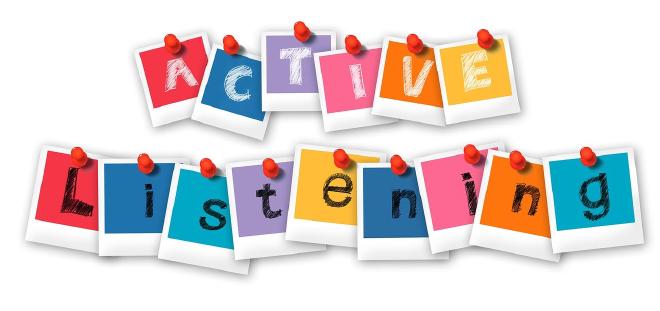

One of the biggest impediments to important conversation, Norm Spaulding told future Frosh 1011 co-leads, is that we don’t communicate nearly as well as we think we do.
Referencing the work of Amanda Ripley, author of High Conflict: Why We Get Trapped and How We Get Out, Spaulding said people often believe they have successfully conveyed their intentions and ideas when they haven’t. But there’s another side to the problem. “We don’t listen carefully, so we misunderstand,” Spaulding said. The higher the stakes of the conversation, the deeper misunderstandings can run.
For the next hour and a half, Spaulding, the Nelson Bowman Sweitzer and Marie B. Sweitzer Professor of Law, guided students through the concept of active listening, which means more than just hearing (and judging) the words a person says. Instead, active listening seeks to understand what is being said and why, especially when there is disagreement. Spaulding interspersed his lecture with interactive, small-group exercises to help students practice the skills with each other.
A culture of constructive dialogue #
The training is part of Spaulding’s work as co-director of ePluribus Stanford, an initiative launched last year to promote constructive dialogue across campus.
ePluribus Stanford grew out of a project Spaulding launched in 2021 with former Dean Paul Brest at Stanford Law School to equip future lawyers with the communications skills they need to engage with divergent viewpoints in and outside the courtroom. After the two collaborated on a 2023 report requested by Stanford’s Office of the President to study polarization, inclusion, and academic freedom at Stanford, it became clear that others could benefit from this work. Through ePluribus Stanford, Spaulding has delivered iterations of the training to over a dozen groups of faculty, students, and staff, including instructors in the COLLEGE program.
Why communication breaks down #
In his workshops, Spaulding draws on research from across the social sciences to underscore the importance of engaging different perspectives.
Spaulding explained that pluralism skills are essential for any democratic society to thrive. A community that doesn’t have differences and disagreements is either homogeneous – everybody shares the same beliefs – or governed by conformity and groupthink. Constructive disagreement is foundational for learning, too: Innovation comes from questioning conventions, and the acquisition of new knowledge often requires reassessing assumptions, recognizing mistakes, and overcoming confirmation bias.
But in a deeply polarized society, differences can be difficult to negotiate. A disagreement can become entrenched and devolve into a situation Ripley has described as “high conflict.”
“High conflict is what happens when discord distills into a good-versus-evil kind of feud, the kind with an us and a them. In this state, the brain behaves differently. We feel increasingly certain of our own superiority, and everything we do to try to end the conflict usually makes it worse,” Ripley wrote in her book, one of five Spaulding recommends for learning to sustain “good” conflict.
“All of us can see examples in public life where conflict and disagreement become dysfunctional and entrenched, where neither is even listening to the other,” Spaulding said.
Active listening is one way to keep heated conversations – be it on political or personal topics – from boiling over into demonization and violence.
Putting active listening into practice #
Frosh 101 is a student-led course, offered in the fall quarter, designed to help first-year students transition to campus life. Upperclass students – called co-leads – serve as guides for discussions about how students can develop a sense of belonging at Stanford.
Those conversations include reflections about one’s background, beliefs, and values. Sometimes, areas of difference and disagreement can emerge in those discussions.
To prepare, Frosh 101 co-leads are trained on leadership and discussion facilitation, including how to navigate difficult conversations using active listening.
Princess Ochweri was a Frosh 101 co-lead last year and returned to the program this year as a teaching assistant. She found the skills from Spaulding’s workshops invaluable – in particular, the concept of “looping,” which is when one person paraphrases what another person stated to demonstrate that the message came across. “When students share deeply personal experiences with us, it’s essential to genuinely understand their perspective,” Ochweri said.
Asking clarifying questions was another useful tip for Ochweri. “In environments where diverse identities intersect, the same thing can hold different meanings for different people,” she added.
Ochweri and fellow Frosh 101 co-lead Nifemi Bankole both emphasized how the tools of active listening help keep assumptions in check. “At Stanford, you are working with a diverse community,” Bankole said. “When you suspend judgment and predispositions, you open yourself to a true understanding and learn insights from people coming from very different walks of life.”
Six steps to active listening #
Stanford law Professor Norm Spaulding shared six tips for understanding what your conversation partner is trying to convey, inspired by advice from the nonprofit organization Center for Creative Leadership.
- Pay full attention
“Being able to give full attention is just an incredible gift to humanize the person you’re communicating with, and that alone can sometimes have a de-escalating effect,” Spaulding said. To show you are paying attention, nonverbal cues also matter. Some of the ways people can demonstrate they are engaged include nodding, maintaining eye contact, and removing distractions.
- Suspend judgment
Judgment is about imposing meaning and preconceived beliefs onto a situation.
“To suspend judgment is to open yourself up to the beautiful aspect of learning something new and understanding more deeply the mistakes that you are making,” Spaulding said.
Moreover, Spaulding added that first impressions can sometimes be wrong. “Once we start judging, we interpret new facts in the light of our first reaction,” Spaulding said. Social scientists call this “confirmation bias,” and it can distort perspective and, in turn, an entire conversation.
- Pause and reflect
Reflecting is connecting with the speaker’s experience on a deeper level, Spaulding said. It brings together analysis with empathy in an effort to find what the Pakistani-British writer Moshin Hamid described as “echoes of another person in yourself.”
Reflecting can be particularly challenging when facing ideas antithetical to one’s own. However, this is precisely when reflection can be most transformative for communication, Spaulding said.
- Ask clarifying questions
Clarifying is critical, Spaulding said. Even if you think you’ve understood, this is your chance to gain further understanding.
Instead of responding to what someone shares with a statement, Spaulding suggests asking an open-ended question, such as: “What are some other examples?” or “How did you become interested in this issue?”
- Summarize
Also sometimes called “looping,” this tells the other person that you understood both what they said and the intention behind it.
“The key is not to give your own conclusion or views but rather try to faithfully describe the essence of what the other person has been trying to say and to summarize it in a way that they would say, ‘That’s exactly what I meant,’” Spaulding said, noting that doing so fosters connection and trust.
- Share
This is the final step. After you’ve confirmed that you’ve correctly understood what your conversation partner has said, it’s your turn.
“In some contexts, friendship and sometimes in mentoring, this might be the moment where you just thank someone for sharing, or start to offer some advice, or you share your perspective or an experience that connects,” Spaulding said.
Bankole said the program has helped him become a more self-aware and patient communicator. “You realize that some things can be misconstrued and it’s best to take time to seek clarification,” he said, adding that sometimes this means assuming the role of clarifier if you notice your conversation partner isn’t validating what you’ve shared. “Communication is nuanced, and you always have to be cognizant of that.”
Spaulding has emphasized how higher education is one of the few remaining spaces in a polarized country where people with fundamentally different backgrounds, beliefs, and ideas live together and interact in a sustained way.
Spaulding hopes that anyone on campus can feel empowered to be a bridge builder.
“If we can get this right here, instead of being a mirror of polarization that’s happening in our larger society, we can be a light, and we can light a pathway to the different forms of engagement,” Spaulding said.
The article Law Professor Norm Spaulding makes the case for active listening, signed by Melissa De Witte was published in Stanford University news section

